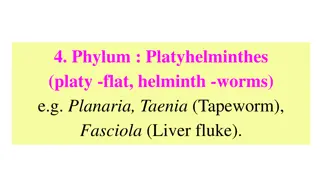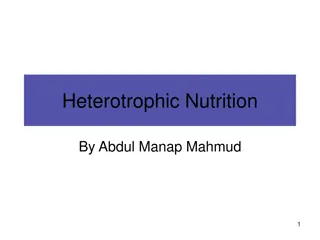Understanding Adaptations in Organisms: from Zebra Stripes to Diabetes
Adaptations in organisms play a crucial role in survival within their ecological niche. This article explores the reasons behind zebra stripes, the impact of traits that may not seem advantageous, the mechanisms of diabetes, and how environmental conditions can influence genetic traits. By delving into topics such as anatomical, physiological, and behavioral adaptations, we gain a deeper understanding of the intricate ways in which organisms evolve and thrive.
Download Presentation

Please find below an Image/Link to download the presentation.
The content on the website is provided AS IS for your information and personal use only. It may not be sold, licensed, or shared on other websites without obtaining consent from the author. Download presentation by click this link. If you encounter any issues during the download, it is possible that the publisher has removed the file from their server.
E N D
Presentation Transcript
Adaptations in Organisms Why did the zebra get it stripes? and answers to other interesting observations
What is an Adaptation? - Adaptations are traits that help organisms survive in their ecological niche or habitat Adaptations can be anatomical, physiological or behavioral Anatomical adaptations are physical features such as an animals shape. Physiological adaptations traits that occur within the body of an organism; typically in relation to metabolism and maintaining homeostasis include the ability to make venom; but also more general functions such as temperature regulation. Behavioral adaptations include an organisms actions or things that it does to survive can be inherited or learned behaviors and include tool use, language, herding etc.
Why Might Traits that Dont Appear Advantageous Exist? Look at the evolutionary history of the organism For example, diabetes in humans What is diabetes?
Diabetes 1. What sugar plays a role in diabetes? Glucose 2. What hormone helps to maintain a proper balance of this sugar? Insulin 3. What disruption in homeostasis occurs in diabetics? The blood sugar (glucose) remains at high levels in the bloodstream
Disruption of homeostasis. 4. If left unmanaged, what are the effects that occur from diabetes? If left unmanaged, high blood sugars can lead to rapid dehydration, coma, and death. Even when it is managed, diabetes can lead to long-term complications including: blindness, heart disease, stroke, and vascular disease
Why is Type 1 diabetes most common in people of Northern European Descent? 12. What environmental condition occurred during the Younger Dryas in Northern Europe? In a decade, average yearly temperatures plunged nearly 30 degrees Sea levels dropped by hundreds of feet as water froze in the ice caps Forests and grasslands went into steep decline and coastlines were surround by hundreds of miles of ice 13. What happens to human tissue when it freezes? When human tissue is frozen, the water in our blood freezes, and the ice shards cut blood cells and cause capillaries to burst (like a pipe in an unheated house)
Why would the condition of high blood sugar be beneficial in cold climates? 15. Why might grapes off-load water and have a sharp increase in sugar at the onset of a cold freeze? The less water in the grape, the fewer ice crystals to damage the membranes of the fruit Ice crystals are only made of pure water when you add a solute (sugar) water will freeze at a lower temperature. Just like antifreeze 18. How does the wood frog change physiologically when it freezes? Just before temperature drops to freezing, it begins to move water out of its organs and blood Instead of urinating it pools water in abdomen this will eventually freeze and keep the rest of the vital organ cool Liver dumps massive amounts of sugar into bloodstream to lower the freezing point of water remaining in bloodstream How does this relate to the environmental condition during the Younger Dryas and diabetes in humans?
Lets look at some other adaptations
Anatomical Adaptations Orchids Mimicry and more! Orchids are examples of Epiphytes They grow in the canopy layer of tropical rainforests Need to have adaptations for obtaining water, enough sunlight and nutrients and reproduction Roots: In addition to anchoring the plants, the roots contain chloroplast and can perform photosynthesis Flowers Brightly colored flowers will attract certain insect pollinators Some species flowers mimic their pollinators Seeds Very light so that they may be carried by the wind Lack the endosperm and will receive nutrients from fungi in the area Stems are enlarged and called pseudo-bulbs Used for water and carbohydrate storage https://www.youtube.com/watch?v=-h8I3cqpgnA
Leafy Sea Dragon -Camouflage Marine organisms - Adapted to hiding in the seaweed and kelp. The leaf-like protrusions that make it so distinctive give it the appearance of seaweed. This helps to trick predators as well as the small fish and crustaceans that the Leafy Sea dragon likes to eat. The Leafy Sea dragon uses tiny translucent fins on its head to steer while similar fins on its back propel it gently through the water, creating the illusion of a piece of floating seaweed. It can even change color to blend in with its surroundings. During reproduction, like it s cousin the sea horse, the male looks after the eggs! The female produces up to 250 bright pink eggs and deposits them on to the male's tail. The eggs then attach themselves to a brood patch , which keeps them supplied with oxygen until the hatch https://www.youtube.com/watch?v=25sHr44Xy9M at 5:18
Zebra -Stripes Stripes - Dazzle effect - it breaks up his outline and makes it harder for predators to judge distances -- throwing off their strikes when hunting - Stripes might confuse certain parasitic flies, since the zebra's patterns don't resemble other mammals from a fly's-eye-view. Teeth - Unlike other mammals, zebras feature large, high-crowned grinding teeth, since many of the grasses they eat feature a high silica content that can wear down teeth. - Males have enlarged canine teeth for fighting. This adaptation is the result of sexual selection; males that perform better in fights have a better chance of getting a mate and reproducing Herding Behavior - Zebra often herd with other animals as well, such as giraffes - more eyes to spot predators -- living in groups enhances some other zebra adaptions. https://youtu.be/JDxvzDLWH4c
Colugo -Gliding Live in the tropical rainforest in Southeast Asia competition is very high Are nocturnal Eyes are large and front-facing Have a flap of skin called the patagium extends from front paw to rear paw. Also webbing between their fingers and toes Of all the gliding mammals, colugos are most skilled Expend little energy Are herbivores eat leaves, shoots, sap, fruits and flowers Intestine is very long in proportion to body size- allows them to extract all the nutrients from their food https://www.youtube.com/watch?v=QkKDHkwq59Y
Butterwort Deadly Leaves The Butterwort also known as the Pinguicula vulgaris, feeds itself by trapping insects. Bright purple flowers are used to attract the insects along with the sticky mucilage on the yellowish bear-haired star shaped leafs. Once the insect is stuck, the leaf edge slowly rolls over. When the insect is digested the leaf unrolls and becomes nearly flat. The plant has to feed on insects to pollinate. These plants are usually found in sunny, open and wet areas where there is less nutrients (nitrogen) in the soil, so the plant has adapted to eating insects, to supplement it s diet. The Genus name Pinguicula means "little fat one" in Latin; this is because of the "fatty" glossy leaves. The common name Steepgrass originated in Europe (Ireland in particular), where it was steeped in milk to curdle it. https://www.youtube.com/watch?v=aladpRIVdRI
Bar-headed Geese High Altitudes Migratory birds over the Himalayas exposed to very high altitudes Structural - Bar-headed geese have a slightly larger wingspan and lower wing loading than other similar goose species yielding greater lift and reducing the power required for flight Bird lungs are superior to mammalian lungs, having a counter exchange system, which extracts O2 much more efficiently and they are larger in bar-headed geese than in other species of waterfowl In hypoxic conditions, bar-headed geese can hyperventilate 7.2 times faster than their rate at sea level, and suffer no ill effects as a result of this (which increases blood pH in humans this makes us restrict blood flow to the brain, causing a dizzy sensation). Their hemoglobin is also adapted to load more O2 to the blood than most other vertebrates Complete most of their journeys not during the day with the uplifting winds at their backs, but during the night or early morning, when headwinds are likely The cooler night and early-morning temperatures would help dissipate body heat and increase oxygen availability, may be more helpful than any tailwind assist
Angler Fish Bioluminescence Live in the Atlantic and Antarctic Oceans 3,000 feet below the surface (benthic) Dark, water is about freezing temperature, not many organisms found at this depth Spine with a flashing rod that is bioluminescent This light will attract other organisms and is how they catch their prey Spine of the dorsal fin acts as a fishing rod this is how the species got its common name Sexual Dimorphism 2 distinct body forms to distinguish sexes Males are much smaller in comparison to females When a male finds a female, the small male ill put himself to her body by biting her belly. His teeth and jaw ill recedes and the skin and blood system will fuse as the animals merge https://www.youtube.com/watch?v=UXl8F-eIoiM
Capuchin Tool Use Live in the rain forests of Central and South America Intelligence Considered the most intelligent of the New World monkeys Will collect rocks , store them, and use them as tools to open hard nuts and shellfish Use twigs to collect honey and insects from trees Learned behavior as they grow older, their ability to use tools effectively increases https://www.washingtonpost.com/news/speaking-of- science/wp/2018/07/06/these-tiny-monkeys-have-entered- their-stone-age-with-a-bang/?utm_term=.d4aa1e081b16
Monarch Butterflies -Migration Habitat is open fields and meadows Adult butterflies consume nectar from flowers strictly liquid diet Proboscis coiled straw that is underneath the head most of the time aids in obtaining nectar Larvae will eat the milkweed plants in which they hatch upon Colorful pattern that makes them easy to Identify- will warn predators away Majority of poison toxin is in the wings and exoskeleton Abdomen is a rough, leathery texture which makes it difficult for predators to bit into Migrate up to 3,000 miles from Southern Canada to Mexico each fall
Birds of Paradise Mating Behaviors Live in tropical rainforests require a humid forest to live Males have spectacular plumage to attract mates Males within some species will put on special displays and dances This species will also produce loud, harsh vocalizations Blue Bird of Paradise will produce a sound that resembles an electric motor humming King of Saxony Bird of Paradise will produce a radio-static sound Females tend to be very quiet https://www.youtube.com/watch?v=L54bxmZy_NE























